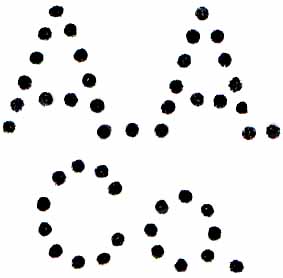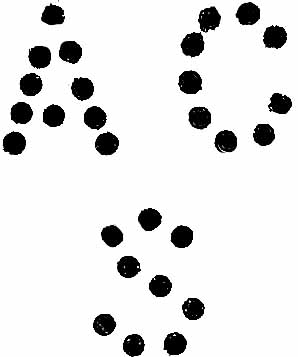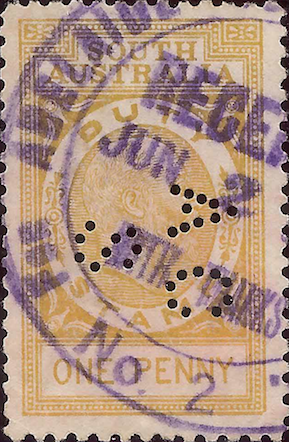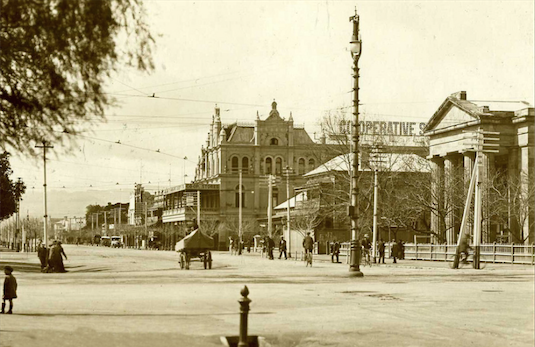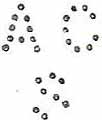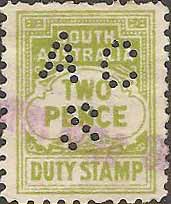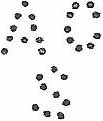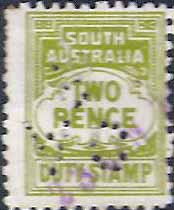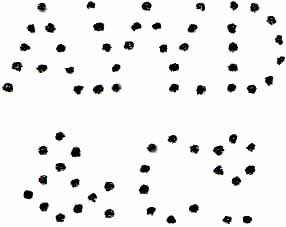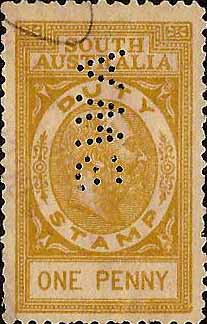|
Private Revenue Perfins of South Australia An Elsmore Coath production The authors would welcome your comments additions or input into this work A -------------------------------------------------------- AA/Co.a
User: Alliance Assurance Co Ltd Life Assurance Address: Universal Buildings, 20 Glenfell St, Adelaide SA. Revenue Use: 1920 Series 2d. Rarity Scale:
1920 Series 2d R3.
Background: *Alliance Assurance were a large English Insurer that was formed by Sir Moses Montefoire and Nathan Rothschild in England in 1824. The company commenced operations in the Australian market in the mid 1830’s and established agents initially in Sydney, but later in Brisbane, Adelaide, Melbourne, Hobart and Perth. The company grew internationally through a series of acquisitions and in Australia this included the Tasmanian Fire Insurance Company in 1892. Device: The Adelaide A.A./Co. device was most likely a single die device. There were similar devices in the Alliance offices in Brisbane and Hobart but these were subtly different. Because these three AA/Co devices are so similar initial reports considered them a single pattern/device. Our research has shown that they are actually three devices and this is confirmed by variation in pin location and the fact that certain varieties only appear on the revenue stamps of the given States. This is further supported by postmark information on postage stamps. The Adelaide device was also known used on Postage stamps from the mid 1930’s until 1948. Related patterns: Refer to other Alliance Assurance patterns in: NSW: ACO…a IC/NA.a SI/O.a Other – NSW: Section 2 Commercial Overprints Alliance/Assurance Ltd.a Alliance/Assce/Co/LTD.a Qld: A.A./Co.a TAS: A.A./Co.a * Alliance Assurance 1824-1924 by Sir William Schooling (1924) Life Insurance in Australia by AC Gray (1977) -------------------------------------------------------- AC/S.a
User: Adelaide Cooperative Society Ltd Merchants Address: 35 Angas St, (Cnr Angas & Nelson Sts), Adelaide, SA. Revenue Use: 1904 Series 1d. Rarity Scale:
1904 Series 1d R3.
Background: *The Adelaide Co-operative Society was formed in 1863 and registered in 1886 and it was the first known co-operative in South Australia. A Co-operative is a form of business like a private or public company except that only shareholders can be involved in the management and conduct of the business. The Adelaide Co-operative Society was a producers, manufacturers and consumers co operative which ultimately sold a huge range of goods including groceries, furnishings, drapery, clothing, furniture, paints, ironmongery, crockery, boots, cake, bread and small goods. The Co-operative was still operating as recently as 1962. Device: Previous studies of the Private Perfins of Australia have identified 2 ACS patterns, however our research has shown that there are in fact 3 distinct ACS patterns as follows: ACS.a used 1913/4-1915 ACS.b used 1915-1920 ACS.c used 1920-1950 The ACS.a is only found used between 1913/4-1915. It is similar in size and scale to ACS.b but the top 3 pins of the A are different. See the article on these ACS Patterns under the Research tab at perfins.com.au. Late strikes of ACS.a often show sections of the inside triangle at the top of the A missing indicating that there was a problem with the device. It seems likely that the device was repaired at this point (1915) and that the repair resulted in the ACS.b pattern. The ACS.a pattern has bold pins and note the pair of pins that make up the second top row of the A. The left hand pin is lower than the right hand pin. The ACS.b pattern is different. Note that the relationship between the pair of pins that make up the 2nd row of the A is reversed to what is found in ACS.a early, now the left hand pin is higher than the right hand pin. Also the left hand base of the A is more splayed. The ACS.a device was a single die device and it is found used on the revenue stamps of SA a well as the postage stamps of Australia. For a study of this pattern group see the Research tab at Perfins.com.au for the article entitled, Co-operative Society Adelaide. Related patterns: Refer to other Adelaide Co-operative Society patterns in: SA: ASC.b ACS.c *coopdevelopment.org.au *Trove
Angas St c1924 -------------------------------------------------------- AC/S.b
User: Adelaide Cooperative Society Ltd Merchants Address: 35 Angas St, (Cnr Angas & Nelson Sts), Adelaide, SA. Revenue Use: 1920 Series 2d. Rarity Scale:
1920 Series 2d R2.
Device: See ACS.a above. The ACS.b device was a single die device and it is found used on the revenue stamps of SA as well as the postage stamps of Australia. Related patterns: Refer to other Adelaide Co operative Society patterns in: SA: ASC.a ACS.c -------------------------------------------------------- AC/S.c
User: Adelaide Cooperative Society Ltd Merchants Address: 35 Angas St, (Cnr Angas & Nelson Sts), Adelaide, SA. Revenue Use: 1920 Series 2d. Rarity Scale:
1920 Series 2d R2.
Background: See ACS.a Device: This pattern is of a slightly larger scale than ACS.a and ACS.b but it retains the same basic format. It is found on issues from 1920 until at least 1950. The usage from the late 1930’s show an increasing number of blind pins, which indicates that the device was deteriorating. The ACS.c device was a single die device and it is found used on the revenue stamps of SA as well as the postage stamps of Australia. Related patterns: Refer to other Adelaide Co operative Society patterns in: SA: ASC.a ACS.b -------------------------------------------------------- AWD/&Co.a.a
User: A W Dobbie & Co Brass Founders and Machinery manufactures and agents Address: Gawler Place, Adelaide, SA. Revenue Use: 1904 Series 1d. Rarity Scale: 1904 Series 1d R1. Background: *Alexander Dobbie was born in Glasgow in 1848 and settled in Adelaide with his family in 1851. He was apprenticed as a brass founder and, at the age of 19 (1867), opened his own foundry. The Dobbie foundry became well known for the range of goods it produced for farm and household use, including several of Dobbie’s own inventions. Alexander was very interested in advances in science and technology and is said to have been the first person in the southern hemisphere to design a working telephone, as well as a phonograph and microphone. In 1876 Dobbie visited the Philadelphia International Exhibition, (USA) and he secured a series of agencies for machinery and musical instruments. Dobbie died in 1912 but the company continued and by 1914, A.W. Dobbie and Co. Ltd. had two business concerns in Adelaide, a brass founders, electro platers and church furniture manufacturers based in Pirie St, and a Machinery importers selling sewing machines, pianos, pumps, bicycles, washing machines and organs, based in Gawler Place. They also had a branch in Perth located at 804-808 Hay St which they established in 1904. Device: The AWD/&Co.a device was most likely a single die device. Previous references on Australian perfins have reported quite a long usage period from as early as 1890 until 1913 but our research indicates a shorter usage from 1899 until 1905. This shorter period is supported by the fact that the pattern is uncommon. It is found used on both postage and revenue stamps of South Australia. Related patterns: Nil *Museum of Victoria *Trove *Australian Dictionary of Biography -------------------------------------------------------- AWS.a
User: A W Sandford & Co Ltd General Merchants, Dairy and Refrigeration Engineers Address: Glenfell St, Adelaide, SA. Revenue Use: 1904 Series 1d. 1906 Two Pence on 1d. Rarity Scale: 1904
Series 1d R4. 1906 Two Pence on 1d R1. Background: *Alexander Wallace Sandford was born in Scotland in 1849 but his family migrated to Victoria in the early 1860’s. He worked in the gold fields and later as a farmer before starting a produce business (most likely pork curing) in Melbourne in 1874. This business had processing facilities in Yarraville and outlets in Melbourne and it is reported that the business flourished. Alexander Sandford moved to Adelaide in 1878, most likely leaving the Melbourne operation in the hands of his brother John. Later in 1883 Alexander established the company in Adelaide, initially as a produce merchant under the name of A W Sandford & Co. He later established branches at Port Adelaide, Mount Gambier as well as one in Western Australia. Alexander Sandford was quick to recognise the potential of machines in the dairy industry and he expanded the business into engineering, making and selling separators and later building large refrigeration plants which were required to preserve diary and farm produce for shipping overseas. Alexander entered the South Australian Legislative Council in 1896 and he also served on the Royal Agricultural Society. Late in his life Alexander suffered from a throat ailment that made speaking difficult and the business was managed by his partners including his brother John. Alexander died in January 1906. In 1911 Alexander’s eldest son James Wallace Sandford (later Sir) took over the running of the company holding the positions of Chairman and Managing Director. James had been born in 1879 and educated initially in Adelaide but completed his studies (in Chemistry) at the University of London. He became a fellow of the Chemical Society, London and toured Europe and the United States of America before returning to Adelaide in 1901 and joining A W Sandford & Co. Under James leadership the company cemented its position in the exportation of dairy and other farm produce as well as being remaining influential general merchants, food processors, engineers and later specialising in the importation of agricultural machinery and general merchandise from Britain. James held many charitable as well as commercial directorships as well as Government Boards and for these and other services he was knighted in 1937. James also followed his father into politics and from 1938-1956 he represented the Liberal and Country League in the Legislative Council in the South Australian State Parliament. James remained in his position as Chairman and Managing Director of A W Sandford & Co until his death in 1958. Device: The AWS.a device was a single die device and this is proved by multiples that show no consistent separation between strikes. The company sought and received approval to use the device in May 1903 and the pattern from the AWS.a is found on both revenue and postage stamps with a usage period of 1903 until at least 1916. Related patterns: Nil *Australian Dictionary of Biography -------------------------------------------------------- © copyright 2011 |
